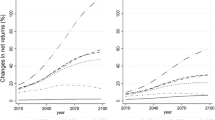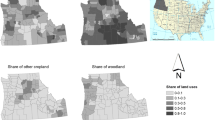Abstract
Crop yields are vulnerable to climate change. We assess the global impacts of climate change on agricultural systems under two climate projections (RCP8.5 and RCP4.5) to quantify the difference in impacts if climate change were reduced. We also employ two different socioeconomic pathways (SSP3 and SSP5) to assess the sensitivity of results to the underlying socioeconomic conditions. The integrated-Population-Economy-Technology-Science (iPETS) model, a global integrated assessment model for projecting future energy use, land use and emissions, is used in conjunction with the Community Earth System Model (CESM), and particularly its land surface component, the Community Land Model (CLM), to evaluate climate change impacts on agriculture. iPETS results are produced at the level of nine world regions for the period 2005–2100. We employ climate impacts on crop yield derived from CLM, driven by CESM simulations of the two RCPs. These yield effects are applied within iPETS, imposed on baseline and mitigation scenarios for SSP3 and SSP5 that are consistent with the RCPs. We find that the reduced level of warming in RCP4.5 (relative to RCP8.5) can have either positive or negative effects on the economy since crop yield either increases or decreases with climate change depending on assumptions about CO2 fertilization. Yields are up to 12 % lower, and crop prices are up to 15 % higher, in RCP4.5 relative to RCP8.5 if CO2 fertilization is included, whereas yields are up to 22 % higher, and crop prices up to 22 % lower, if it is not. We also find that in the mitigation scenarios (RCP4.5), crop prices are substantially affected by mitigation actions as well as by climate impacts. For the scenarios we evaluated, the development pathway (SSP3 vs SSP5) has a larger impact on outcomes than climate (RCP4.5 vs RCP8.5), by a factor of 3 for crop prices, 11 for total cropland use, and 35 for GDP on global average.






Similar content being viewed by others

Notes
Both RCP4.5 and RCP8.5 without CO2 fertilization cause crop yields in USA to decrease, however, RCP4.5 induces higher yield loss than RCP8.5 in USA in 2061–2080. In other time periods, yield under RCP4.5 is higher than RCP8.5.
References
Armington PS (1969) A theory of demand for products distinguished by place of production. IMF Staff Pap 16(1):159–178
Arora VK et al. (2013) Carbon–concentration and carbon–climate feedbacks in CMIP5 earth system models. J Clim 26:5289–5314
Beach RH et al. (2015) Climate change impacts on US agriculture and forestry: benefits of global climate stabilization. Environ Res Lett 10:095004
Brenkert AL, Smith SJ, Kim SH, Pitcher HM (2003) Model documentation for the MiniCAM. PNNL-14337, Pacific Northwest National Laboratory, Richland. Available at:http://www.globalchange.umd.edu/data/publications/MiniCAM.pdf
Calvin K et al. (2016) The SSP4: A world of deepening inequality. Glob Environ Chang.. doi:10.1016/j.gloenvcha.2016.06.010
EPA (2015) Climate Change in the United States: Benefits of Global Action. United States Environmental Protection Agency, Office of Atmospheric Programs, EPA 430-R-15-001
Fisher G et al. (2005) Socio-economic and climate change impacts on agriculture: an integrated assessment 1990-2080. Philosophical Transactions B 360:2067–2083
Hasegawa H et al. (2013) Climate change impact and adaptation assessment on food consumption utilizing a new scenario framework. Environ Sci Technol 48(1):438–445
Hasegawa H et al. (2015) Consequence of climate mitigation on the risk of hunger. Environ Sci Technol 49:7245–7253
Kimball BA (2010) Lessons from FACE: CO2 effects and interactions with water, nitrogen, and temperature. In: Hillel D, Rosenzweig C (eds) The handbook of climate change and Agroecosystems. Imperial College Press, Singapore, pp. 87–107
Levis S et al. (2016) CLMcrop yields and water requirements: avoided impacts by choosing RCP 4.5 over 8.5. Clim Chang. doi:10.1007/s10584-016-1654-9
Lobell DB, Gourdji SM (2012) The influence of climate change on global crop productivity. Plant Physiol 160:1686–1697
McGrath J, Lobell DB (2013) Regional disparities in the CO2 fertilization effect and implications for crop yields. Environ Res Lett 8:014054
Meiyappan PM et al. (2014) Spatial modeling of agricultural land use change at global scale. Ecological Modeling 291:152–174
Monfreda C et al. (2008) Farming the planet 2 geographic distribution of crop areas, yields, physiological types, and net primary production in the year 2000. Glob Biogeochem Cycles 22
Nelson GC et al. (2014) Agriculture and climate change in global scenarios: why don’t the models agree. Agric Econ 45(1):69–84
O’Neill BC et al. (2014) A new scenario framework for climate change research: the concept of shared socioeconomic pathways. Clim Chang 122(3):387–400
O’Neill BC et al. (2015) The roads ahead: narratives for shared socioeconomic pathways describing world futures in the twenty-first century. Glob Environ Chang. doi:10.1016/j.gloenvcha.2015.01.004
Oleson KW et al. (2013) Technical description of version 4.5 of the community land model (CLM). NCAR technical note NCAR/TN-503 + STR. National Center for Atmospheric Research, Boulder. doi:10.5065/D6RR1W7M
Rosenzweig C et al. (2014) Assessing agricultural risks of climate change in the twenty-first century in a global gridded crop model intercomparison. Proc Natl Acad Sci 111:3268–3273
Schlenker W, Roberts MJ (2009) Non-linear temperature effects indicate severe damages to U.S. crop yields under climate change. Proc. Natl. Acad Sci 106:15594–15598
Schmidhuber J, Tubiello F (2007) Global food security under climate change. Proc Natl Acad Sci 104(50):19703–19708
Tebaldi C, Lobell DB (2015) Estimated impacts of emission reductions on wheat and maize crops. Clim Chang. doi:10.1007/s10584-015-1537-5
van Vuuren DP et al. (2011) The representative concentration pathways: an overview. Clim Chang 109:5–31
von Lampe M et al. (2014) Why do global long-term scenarios for agriculture differ? An overview of the AgMIP global economic model intercomparison. Agric Econ 45(1):3–20
Wiebe K et al. (2015) Climate change impacts on agriculture in 2050 under a range of plausible socioeconomic and emissions scenarios. Environ Res Lett 10(8):085010
Acknowledgments
This paper is based upon work supported by the National Science Foundation under Grant Number AGS-1243095. Any opinions, findings, conclusions, or recommendations expressed in this article are those of the authors and do not necessarily reflect those of the funders.
Author information
Authors and Affiliations
Corresponding author
Additional information
This article is part of a special issue on “Benefits of Reduced Anthropogenic Climate changE (BRACE)” edited by Brian O’Neill and Andrew Gettelman
Electronic supplementary material
ESM 1
(PDF 1.91 MB)
Rights and permissions
About this article
Cite this article
Ren, X., Weitzel, M., O’Neill, B.C. et al. Avoided economic impacts of climate change on agriculture: integrating a land surface model (CLM) with a global economic model (iPETS). Climatic Change 146, 517–531 (2018). https://doi.org/10.1007/s10584-016-1791-1
Received:
Accepted:
Published:
Issue Date:
DOI: https://doi.org/10.1007/s10584-016-1791-1



